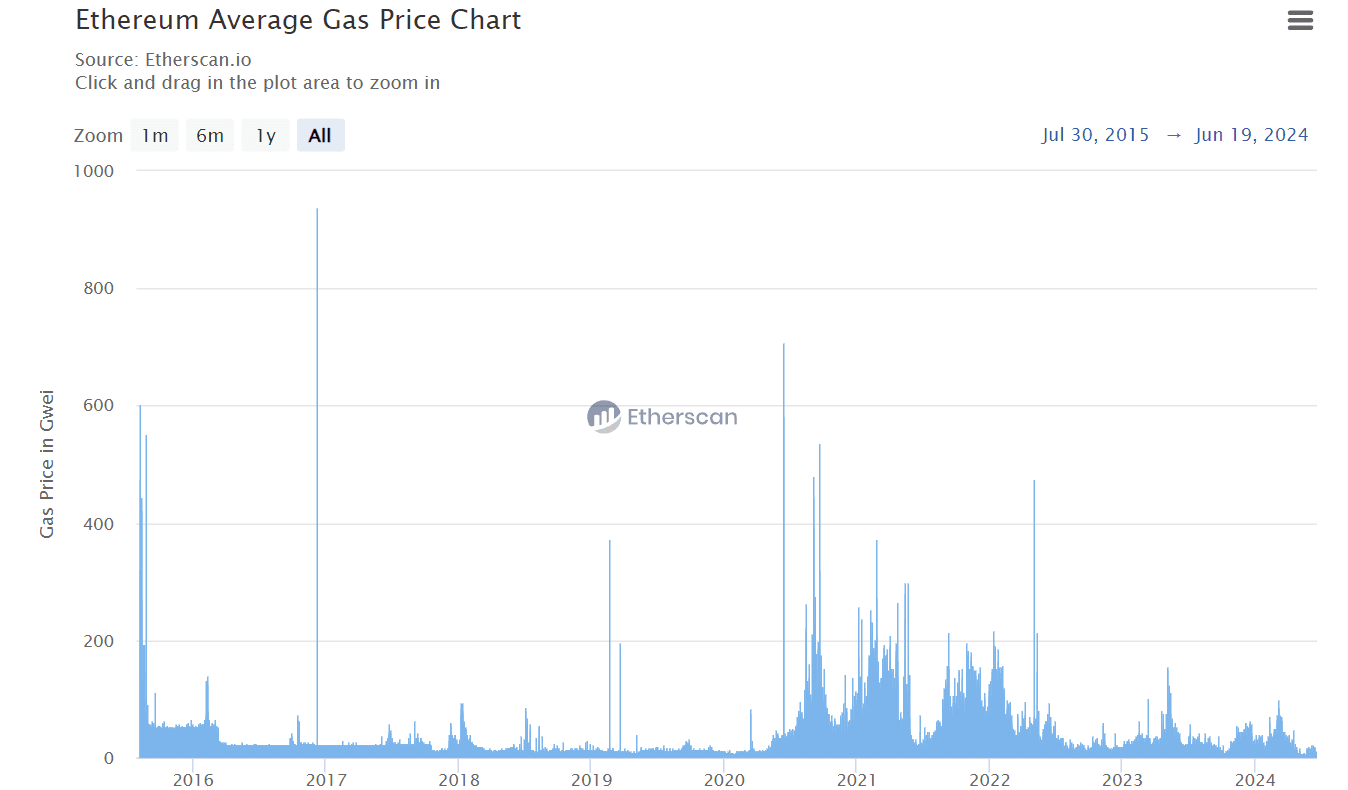[key_takeaways]
- Cryptocurrency transaction fees vary based on network congestion, transaction complexity, and blockchain technology.
- Minimize costs by transacting during low congestion periods and using Layer-2 solutions.
- Bitcoin's average transaction fee has risen significantly, currently at $6.956, emphasizing the importance of understanding fee dynamics.
- Fees compensate miners/validators, prevent spam, and influence transaction speed and blockchain security.
- Future fee trends may be impacted by scaling solutions, increased adoption, and regulatory changes.
[/key_takeaways]
Short Summary:
Cryptocurrency transaction fees vary based on factors like network congestion, transaction complexity, and the underlying blockchain technology.
Strategies to minimize these costs include transacting during low congestion periods and using technologies such as Layer-2 solutions. Future transaction fees may fluctuate with increased adoption and potential regulatory changes.
In 2024, navigating the ever-evolving world of cryptocurrency requires a keen understanding of transaction fees. As reported by YCharts on June 10, 2024, Bitcoin's average transaction fee has risen over 200% in the past year, currently sitting at $6.956.

This volatility highlights the importance of comprehending the factors that influence these fees.
This guide dives deep into the complexities of crypto transaction fees, exploring how network congestion, data size, and even chosen protocols all play a role.
We'll also unveil the structure of these fees and explore strategies to minimize their impact on your crypto activities.
What are cryptocurrency transaction fees?
Cryptocurrency transaction fees are small amounts paid by users to compensate miners or validators for processing their transactions on the blockchain.
These fees are not only crucial for the operation and security of the blockchain but also influence the speed at which a transaction is confirmed.
Factors influencing crypto fees
- Network congestion: More transactions waiting to be processed typically increase network fees as users bid higher to get their transactions confirmed faster.
- Transaction complexity: Transactions involving complex contracts or large amounts of data require more computational power and, thus, higher fees.
- Blockchain capacity: Each block has a limited size, meaning only a certain number of transactions can be included in a single block.
The chart below compares average transaction fees across major blockchains, such as Bitcoin, Ethereum, Ripple, and others, over the past year.
Notice the spikes in Ethereum fees corresponding to network congestion due to the popularity of decentralized finance (DeFi) applications.
| Blockchain | Average Fee (USD) | Peak Fee in 2024 (USD) |
| Bitcoin | $6.96 | $10.28 |
| Ethereum | $2.50 | $50.00 |
| Ripple | $0.01 | $0.02 |
| Litecoin | $0.10 | $0.20 |
| Solana | $0.005 | $0.01 |
| Cardano | $0.04 | $0.10 |
| BNB Chain (Binance Smart Chain) | $0.10 | $0.50 |
The graph below illustrates the fluctuation of Ethereum's gas fees from July 2023 to June 2024, highlighting significant variations during periods of network overload, typically triggered by mass trading activities or large-scale smart contract executions.

Source: Etherscan.io
By understanding these fees and their drivers, users can better plan their transactions. They can potentially opt for times of lower network activity to minimize costs or choose a blockchain that aligns with their fee tolerance and transaction urgency.
Why do you need to pay cryptocurrency transaction fees?
Cryptocurrency transaction fees are integral to the functionality and sustainability of blockchain networks. Here's why paying these fees is necessary:
- Compensation for miners/validators: Transaction fees serve as an incentive for miners and validators to process transactions. These fees compensate them for the computing power and electricity expended in securing transactions on the blockchain.
- Prevention of spam transactions: Fees act as a deterrent against spam transactions, which could otherwise flood and paralyze the network. By requiring a fee, only serious transactions are processed, helping to maintain the network’s performance and security.
- Prioritization of transactions: During times of high traffic, transaction fees can vary. Users willing to pay a higher fee can have their transactions processed faster, thus implementing a competitive and efficient transaction queue.
What is the impact of transaction fees on cryptocurrency adoption and use?
The impact of transaction fees on cryptocurrency adoption and usage is significant and complex.
These fees affect both the accessibility and cost-effectiveness of using cryptocurrencies for everyday transactions and large-scale transfers.
High fees can deter new users and limit the practicality of cryptocurrencies for small payments, while also challenging scalability as the network grows.
Conversely, effectively managed fees can enhance user experience and broaden the appeal of cryptocurrencies as a viable alternative to traditional financial systems.
📚Read more: How Much Does It Cost to Send Tether (USDT)

How do crypto transaction fees work?
Cryptocurrency transaction fees are essential mechanisms within blockchain networks, ensuring not only the security but also the efficiency of transactions. Here’s a simplified breakdown of how these fees function:
- Transaction validation: Miners on networks like Bitcoin or validators on Ethereum select transactions to process. They prioritize transactions based on the fee attached — higher fees generally mean quicker processing.
- Fee market: Just as in a traditional auction, users submit a bid (the transaction fee) to get their transaction processed faster. This creates a dynamic market where the fees can fluctuate based on network demand.
- Network rules: Each blockchain has specific rules that influence how transaction fees are calculated. These might include the size of the transaction in bytes for Bitcoin, or the computational complexity for Ethereum.
How are transaction fees calculated?
Transaction fees are determined by several factors that vary from one blockchain to another. Here’s an overview of the most common considerations:
- Transaction size: On blockchains like Bitcoin, fees are often calculated based on the size of the transaction in kilobytes. Larger transactions that take up more space in a block cost more.
- Network congestion: If many users are sending transactions at the same time, the demand for block space increases, leading to higher fees. During these peak times, users can choose to pay a premium to have their transactions processed faster.
- Complexity of the transaction: Some transactions are more complex than others. For example, a transaction involving smart contracts, as seen with Ethereum, can require more computational power and thus incurs higher fees.
- Fee rate recommendations: Many wallets provide recommended fee rates based on current network conditions, which users can adjust depending on how quickly they need their transaction confirmed.
- Exchange rate: A Bitcoin exchange calculates trading fees based on the percentage of the transaction amount, which can influence the total cost especially for those who buy sell frequently.
📚Related: How to Calculate the Exchange Rate?
Understanding these factors can help users navigate the cost implications of their transactions.
Users can decide the best times to transact, or whether to adjust their fee offerings based on urgency and network conditions.
Types of cryptocurrency transaction fees
Cryptocurrency transaction fees can vary significantly across different networks and transactions. Understanding these differences is crucial for users who need to manage their transaction costs effectively.
Below are the main types of fees associated with cryptocurrency transactions:
Network fees
Network transaction fees, also known as miner or validator fees, are paid directly to the blockchain network's miners or validators who process transactions. These fees:
- Ensure that transactions are added to the blockchain.
- Vary depending on the blockchain’s current level of congestion and the transaction's data size.
- Serve as an incentive for miners to include a transaction in the next block, especially during times of high network activity.
Transaction fee structures
Different cryptocurrencies have distinct fee structures determined by their specific blockchain protocols. Common structures include:
- Flat Fee: Some blockchains or exchanges may charge a static fee for all transactions, regardless of size or complexity.
- Dynamic Fees: Most major blockchains, such as Bitcoin and Ethereum, calculate fees based on transaction size and network congestion. Users can often choose to pay a higher fee for faster confirmation.
- Percentage Fees: Certain platforms, particularly exchanges, charge a fee based on the percentage of the transaction value. This is particularly common in trades involving the exchange of cryptocurrencies or when converting crypto to fiat currencies.
Maker and Taker Fees
These are specific types of fees that apply on cryptocurrency exchanges during trading activities. Makers are traders who provide liquidity by placing a limit order under the last trade price for buys and above for sells.
Takers are those who remove this liquidity by placing an order that matches (or 'takes') the makers' orders.
- Maker Fees: Typically lower than taker fees, these are charged to traders who add orders to the order book, helping to 'make' the market. Makers increase the market depth and liquidity, which is beneficial for the trading ecosystem.
- Taker Fees: These fees are charged to traders who fulfill ('take') orders from the order book, thus removing liquidity from the market. Taker fees are usually higher because takers reduce the market depth and liquidity.
Smart Contract execution fees
In blockchains that support smart contracts, such as Ethereum, there are fees specifically associated with the execution of these contracts. These fees:
- Are required to compensate for the computational energy used to execute complex contract functions.
- Can vary greatly depending on the operational complexity and the current gas price, which is a measure of how much processing power is required.
- Are critical to prevent spam on the network and ensure that developers write efficient code.
Understanding these fee types and their implications can help users make informed decisions about when and how to conduct transactions on various cryptocurrency networks.
This can potentially save significant amounts on fees while ensuring timely transaction processing.

Crypto transaction fees: Real-world examples
Cryptocurrency transaction fees can vary widely depending on several factors, including the chosen network, the urgency of the transaction, and overall network congestion.
Here are five practical scenarios that illustrate how transaction fees can play out in real-world situations:
1. Sending Bitcoin during peak times
- Situation: Alice decides to transfer Bitcoin to Bob during a time of significant market activity, such as during a price surge or drop.
- Impact: Due to the increased demand for transaction processing at this time, the network is highly congested. Alice needs the transaction to go through quickly, so she pays a higher transaction fee to ensure her transaction is prioritized by miners.
- Outcome: Alice's transaction is processed within the next block, but the fee is substantially higher than it would have been during a quieter period.
📚Read More: How to Withdraw Crypto to Bank Account
2. Executing a complex Ethereum Smart Contract
- Situation: Phill uses an Ethereum-based DApp to purchase an insurance policy, which involves complex contract interactions and multiple state changes.
- Impact: This type of transaction requires more computational resources to execute the smart contract functions, resulting in higher gas costs. Additionally, the network is moderately busy, increasing gas prices further.
- Outcome: Phill’s transaction is successful, but the cost reflects the complex nature of the transaction and the current gas price, which is influenced by network activity levels.
3. Trading on a DEX (Decentralized Exchange)
- Situation: Chloe decides to trade ERC-20 tokens on a decentralized exchange, which involves interacting with a smart contract to execute trades directly on the blockchain.
- Impact: Each trade Chloe makes requires a gas fee for the execution of a smart contract. During periods of low congestion, these fees can be minimal. However, if the network is congested, Chloe might have to pay a significant amount in gas fees or opt for a slower transaction at a lower cost.
- Outcome: Chloe monitors the gas prices and chooses a time when the network is less congested to execute her trades, effectively managing her transaction costs but possibly facing delays in order execution.
4. Microtransactions for online content
- Situation: Emily decides to use a small amount of Bitcoin to pay for premium articles on a content platform that accepts cryptocurrency microtransactions.
- Impact: The cost of the transaction is relatively low due to the small amount transferred, but the standard Bitcoin network fee makes the total cost disproportionately high compared to the actual content price.
- Outcome: Emily opts to use a cryptocurrency designed for microtransactions, such as Nano or Stellar, which offer negligible fees. This ensures that her transaction is economical and fast without unnecessary overhead.
📚Read More: How to Pay with Bitcoin, How to Pay with USDT, How to Spend Ethereum
5. Withdrawing crypto to a private wallet
- Situation: David wants to transfer his Ethereum holdings from an exchange to his private wallet for security reasons.
- Impact: The exchange imposes a withdrawal fee, which is added to the network's gas fee required to process the transaction on the Ethereum blockchain. With network congestion relatively high, the combined fees increase significantly.
- Outcome: David waits for a period of lower network activity before initiating the withdrawal, reducing the total fees paid. Additionally, he consolidates several smaller amounts into one larger transaction to further decrease the fee per unit of cryptocurrency moved, optimizing the cost-effectiveness of the transfer.
📚Related: How to Transfer Bitcoin to Another Wallet
These examples highlight the variability of crypto transaction fees and underscore the importance of timing and network choice in managing costs. By understanding these dynamics, users can make more informed decisions that balance cost, speed, and security.
Crypto transaction cost analysis for different use cases
Analyzing the cost of crypto transactions across different scenarios can provide a clearer understanding of how various factors impact fees.
Below is a table that outlines typical transaction costs associated with common activities within the cryptocurrency landscape:
| Use Case | Blockchain | Average Fee | Description of Cost Factors |
| Simple Bitcoin Transfer | Bitcoin | $1 - $5 | Costs vary mainly due to network congestion; higher during peak times. |
| Ethereum Smart Contract | Ethereum | $10 - $50 | Dependent on contract complexity and gas price, which fluctuates. |
| Trading on a DEX | Ethereum | $5 - $100 | Influenced by order complexity and current gas prices. |
| Microtransactions | Lightning Network | $0.01 - $0.10 | Very low due to off-chain transaction capabilities. |
| Cross-Border Money Transfer | Ripple | $0.02 - $0.40 | Relatively low due to efficient network design for large transfers. |
| NFT Purchase | Ethereum | $10 - $100 | High due to the data-heavy nature of NFT transactions and gas fees. |
| Token Swap on DeFi Platform | Ethereum | $15 - $100 | Costs can be high during peak times due to complex smart contract interactions. |
[note title="Note:"]
Cryptocurrency transaction fees can fluctuate significantly based on network demand and congestion. The fees listed are ranges and may not reflect the exact cost at any given moment.
For the most current fee information, it’s advisable to check the latest data from reliable cryptocurrency fee tracking sources.
[/note]
Crypto transaction fees comparison across blockchains
Here is a comparison of typical transaction fees across various prominent blockchains, helping to highlight the cost differences for carrying out similar transactions on each network:
| Blockchain | Average Fee (Low Congestion) | Average Fee (High Congestion) | Fee Influencers |
| Bitcoin (BTC) | $1 - $3 | $5 - $60 | Transaction size, network congestion |
| Ethereum (ETH) | $2 - $5 | $10 - $100 | Gas price, contract complexity |
| Ripple (XRP) | <$0.01 | <$0.01 | Low, stable fees due to network design |
| Cardano (ADA) | $0.20 - $0.30 | $0.20 - $0.30 | Low, stable fees; designed for predictability |
| Solana (SOL) | $0.00025 | $0.01 | High throughput, low fees even at peak times |
| Binance Smart Chain (BSC) | $0.01 - $0.10 | $0.10 - $0.50 | Network capacity, BNB price stability |
[note title="Note:"]
Cryptocurrency transaction fees can fluctuate significantly based on network demand and congestion. The fees listed are ranges and may not reflect the exact cost at any given moment.
For the most current fee information, it’s advisable to check the latest data from reliable cryptocurrency fee tracking sources.
[/note]
How do transaction fees in cryptocurrencies compare to traditional payment methods
Typical transaction fees for cryptocurrencies are juxtaposed with those of traditional payment methods, emphasizing cost-effectiveness, especially in scenarios like cross-border transactions and microtransactions.
This comparison illuminates the financial implications of different payment options for various types of transactions.
| Payment Method | Typical Transaction Fees | Remarks |
| Cryptocurrencies (Bitcoin) | $1 - $60 depending on network congestion | Costs can vary greatly; generally higher for small amounts but fixed per transaction regardless of amount. |
| Cryptocurrencies (Ethereum) | $2 - $100 depending on contract complexity | Fees can be high during network congestion due to gas prices. |
| Credit/Debit Cards* | 1.15% - 3.30% of transaction value | Fees include interchange fees, assessment fees, and potential additional charges by merchants. |
| Bank Transfers (Domestic) | $0 - $25 per transaction | Often free for personal accounts; fees for business accounts and expedited transfers. |
| Bank Transfers (International) | $15 - $50 per transaction | High costs due to intermediary banks and currency conversion; fixed fee plus a percentage of the transferred amount. |
| Wire Transfers** | $10 - $30 domestically, $35 - $50 internationally | Fixed fees; higher for international transfers due to processing across multiple banks. |
| PayPal/Venmo | 0.5% - 3% depending on payment source | Fees for instant transfers and credit card payments; no fee for standard transfer from linked bank account. |
*Credit and debit card fees vary depending on the card issuer, network (Visa, Mastercard), and type of transaction (domestic vs. international).
**Wire transfer fees can vary depending on the bank, transfer amount, and destination country.
[note title="Note:"]
All information provided is dated 14 June 2024 and may have been updated since.
Fees can change over time and may vary by provider, so for the most current fee information, it’s advisable to check directly with the service provider or a reliable financial information source.
[/note]
How to reduce cryptocurrency transaction fees?
Reducing transaction fees is crucial for anyone engaged in frequent cryptocurrency transactions.
Understanding how fees work and the factors that influence their size can help you minimize costs over time.
Here are strategies to effectively reduce transaction fees:
Choose the right time to transact
- Low network congestion: Transaction fees can vary significantly depending on network activity. Transacting during periods of low congestion can lead to lower fees. Tools like blockchain explorers can help you monitor network activity and choose an optimal time to send your transaction.
- Off-peak hours: The cost to transact is often lower during off-peak hours, such as late at night or early in the morning, especially on networks that experience high daytime trading volumes.
Adjust transaction fees manually
- Customize fee settings: Many cryptocurrency wallets allow you to choose the transaction fee you’re willing to pay. Opting for a lower fee is viable when you’re not in a hurry, as it might mean a longer confirmation time.
- Use fee estimator tools: Utilize integrated tools in your crypto wallet or third-party services to suggest an appropriate fee based on current network conditions and your urgency level. Frequent trading on Bitcoin exchanges can benefit from monitoring the exchange rate closely to take advantage of lower fees charged during optimal trade times.
Utilize SegWit and Layer-2 solutions
- SegWit addresses: Using SegWit-enabled wallet addresses can reduce the size of your Bitcoin transactions, thereby lowering the fee. SegWit addresses typically start with '3' or 'bc1'.
- Layer-2 solutions: For networks like Ethereum, consider using Layer-2 solutions that process transactions off the main chain. The Lightning Network significantly lowers Bitcoin transaction fees by enabling off-chain transactions. Solutions like the Lightning Network for Bitcoin or platforms like Polygon for Ethereum offer much lower fees.
By applying these strategies, you can optimize the costs associated with transacting in cryptocurrencies, making your operations more efficient and cost-effective.
Always stay informed about the latest developments in blockchain technology that might offer new ways to minimize fees.

The future of crypto transaction fees
As the cryptocurrency landscape continues to evolve, several key trends could significantly impact the structure and size of transaction fees.
Understanding these potential changes is crucial for anyone involved in the crypto space.
Advancements in blockchain technology
- Scaling solutions: Innovations such as sharding in Ethereum and the continued development of Layer-2 solutions aim to increase transaction throughput. These advancements could significantly reduce fees by alleviating network congestion, a major factor in fee spikes.
- Improved efficiency: As blockchain protocols become more efficient, transaction processing speeds up, which can reduce the need for higher fees to prioritize processing. Techniques like state channels, sidechains, and off-chain transactions promise to enhance efficiency.
Increased adoption and mainstream integration
- Market expansion: As more businesses and consumers adopt cryptocurrency for everyday transactions, we could see an increase in network activity that may drive fees higher unless adequately addressed by technological advancements.
- Diversification of usage: With cryptocurrencies finding use in a wider range of applications, from microtransactions in gaming to large-scale financial settlements, tailored solutions might develop to optimize fees for different types of transactions.
Regulatory changes and Institutional Involvement
- Government oversight: Potential regulation could introduce both challenges and opportunities. For example, legal frameworks might mandate a cap on fees or the introduction of standardized fee structures to enhance user protection and market stability.
- Institutional adoption: As more financial institutions incorporate blockchain technology, there could be an increase in demand for professional, compliant, and possibly higher-cost services, which might influence the overall fee landscape.
These trends suggest a dynamic future for cryptocurrency transaction fees, with possible reductions through technological advancements counterbalanced by increases due to broader adoption and regulatory involvement. Staying informed and adaptable will be key to navigating this evolving space.
Conclusion
As the cryptocurrency world continues to mature and expand, understanding the dynamics of transaction fees becomes increasingly important.
Whether you're a casual user, a serious trader, or a blockchain developer, grasping how fees work and how they can be minimized is crucial for optimizing your blockchain activities.
Future technological advancements and potential regulatory changes may significantly impact these costs, making it vital to stay informed and agile.
By leveraging new technologies and maintaining an awareness of network conditions, users can strategize their transactions to ensure cost-effectiveness and efficiency.
FAQs
What are the lowest transaction fees for popular cryptocurrencies?
The lowest transaction fees vary, with networks like Ripple (XRP) and Stellar (XLM) often costing less than a cent per transaction, while larger networks like Bitcoin and Ethereum can vary greatly depending on network congestion and transaction complexity.
Why does crypto have so many fees?
Cryptocurrency transaction fees compensate miners and validators for the energy and resources used to process transactions and secure the blockchain network.
Fees also help prevent spam transactions that could clog the network.
How much does it cost to trade crypto?
Trading costs can include exchange fees, which range from 0.1% to 1% per trade, and network fees for withdrawals, which vary by cryptocurrency and network congestion.
Why are crypto fees so high?
Crypto fees can be high during periods of intense network congestion when the demand for transaction processing exceeds the network's capacity to process transactions quickly.
Why are Ethereum transaction fees generally higher than Bitcoin's?
Ethereum transaction fees can be higher due to the ability to run complex smart contracts, which require more computational resources than simple transactions.
Is there a way to avoid network transaction fees?
Although completely avoiding transaction fees is not typically possible, using networks with lower fees, transacting during off-peak times, or utilizing Layer-2 solutions can significantly reduce costs.
How can I lower my cryptocurrency transaction fees?
You can lower your fees by choosing the right time to transact, adjusting the fee settings in your wallet, and using cryptocurrencies and platforms known for lower fees.
Is it cheaper to transfer BTC or ETH?
Transferring BTC or ETH can be cheaper depending on the specific network conditions at the time of the transaction. Typically, BTC transactions might be cheaper during times of low ETH network congestion, and vice versa.
Is credit card processing secure?
Credit card processing is generally secure if proper security measures are in place, such as encryption, secure payment gateways, and compliance with PCI DSS standards.
However, users should always be cautious and use trusted platforms.

